Top High-Probability Options Trading Strategies
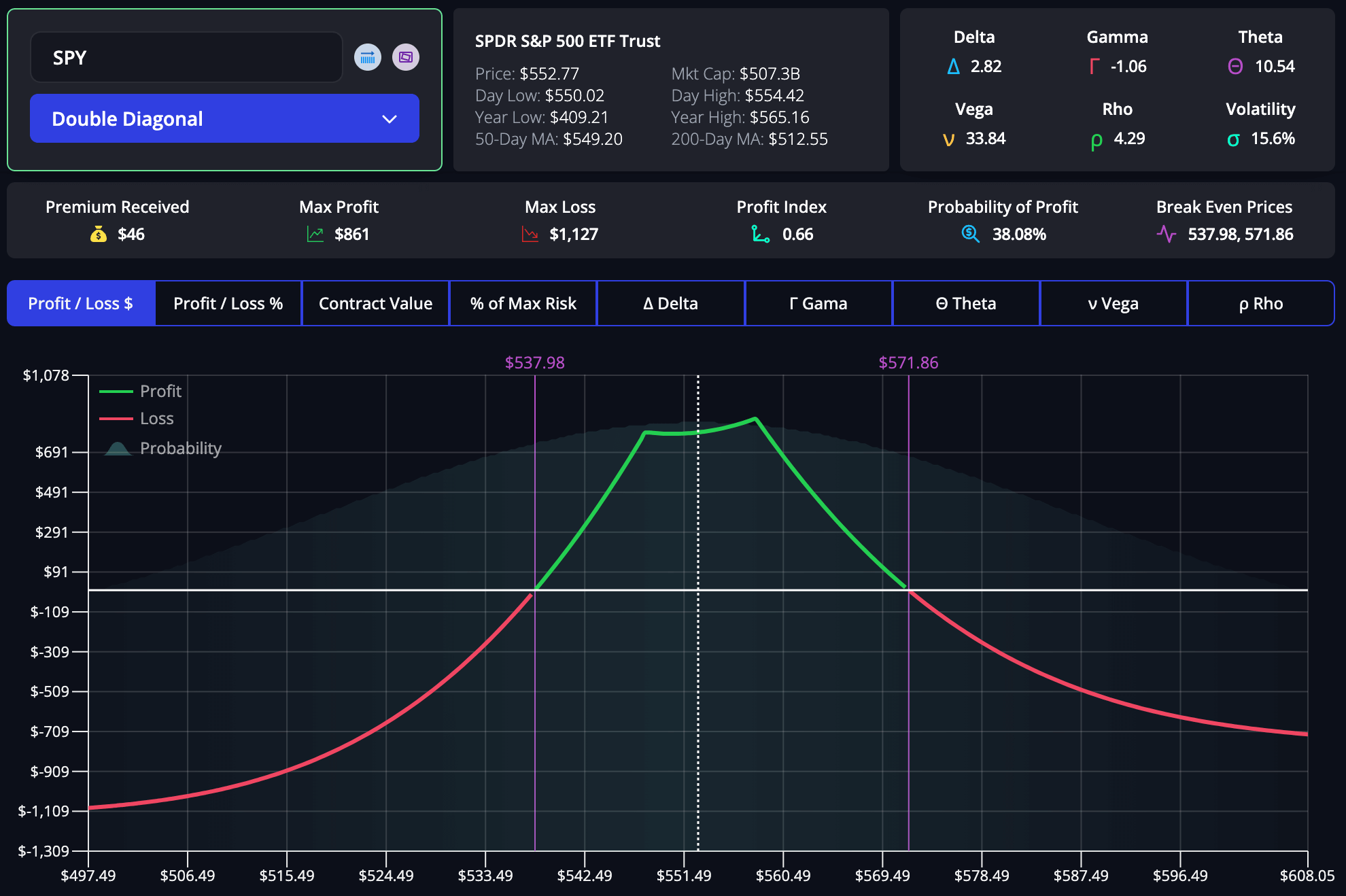
Imagine having the tools to consistently generate profits while managing your risks, even in unpredictable markets.
Options trading doesn’t have to be a gamble. With the right strategies, you can tip the odds in your favor, making your trades more calculated and your outcomes more predictable.
In this guide, we’re going to dive deep into the top options trading strategies that offer a higher probability of success, particularly when used in the right market environment. From the steady income potential of covered call writing to the profit-maximizing setup of butterfly spreads, each strategy is meticulously designed to help you achieve your trading goals.
This isn’t just a list of strategies. We go beyond the basics to show you how to adapt each strategy to real-world market conditions, providing a roadmap to becoming a more successful and informed options trader.
1. Covered Call Writing
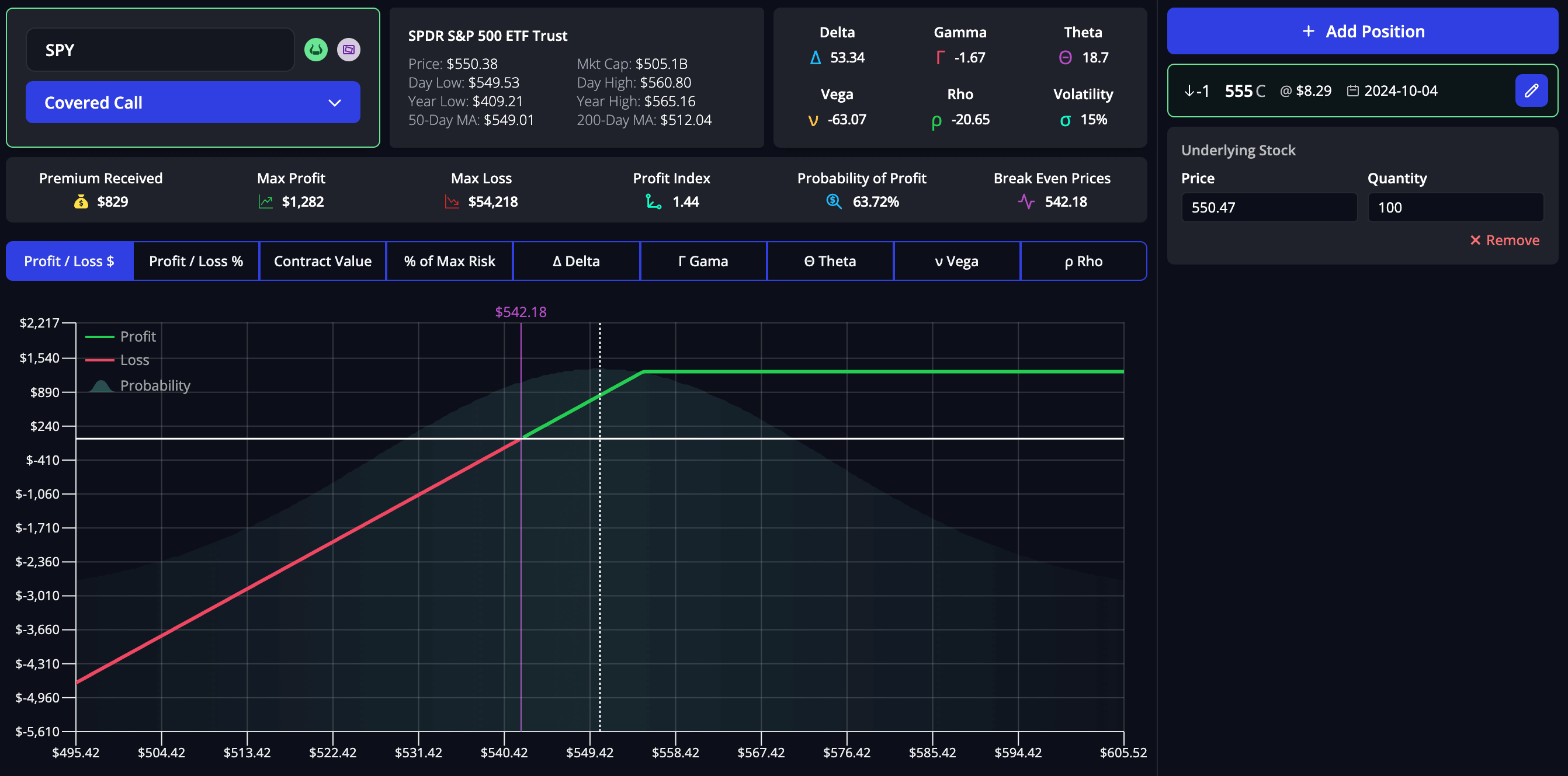
Covered call writing is a strategy where the trader owns shares of a stock and sells a call option on the same stock. This approach allows the trader to generate income from the option premium while holding the underlying asset, effectively reducing the cost basis of the stock.
How Covered Call Writing Works
- Stock Ownership: The trader owns shares of the underlying stock.
- Call Option Selling: The trader sells a call option with a strike price typically slightly above the current market price of the stock. This option gives the buyer the right, but not the obligation, to purchase the stock at the strike price before expiration.
Covered Call Profitability
- Premium Income: The Covered Call strategy profits primarily from the premium received from selling the call option.
- Minimal Price Movement: If the stock price remains flat or rises only slightly, the call option is likely to expire worthless, allowing the trader to keep the premium while still holding the stock.
- Limited Upside: If the stock price rises significantly, the trader’s profit is capped at the strike price plus the premium received, making the strategy less risky compared to outright stock ownership as it offers partial downside protection.
Covered Call Market Conditions
Covered call writing is particularly effective in certain market conditions. To maximize the strategy's potential, traders should adapt their approach based on the prevailing market environment:
- Bullish Markets: In a strongly bullish market, covered call writing may limit potential profits since the stock could be called away if it rises above the strike price. To adapt, traders might select higher strike prices for the call options, allowing for more capital appreciation while still collecting some premium. Alternatively, traders can use shorter expiration dates, which enables them to reassess the market conditions more frequently and adjust their strategies accordingly.
- Neutral or Sideways Markets: This is the ideal condition for covered call writing. In a neutral market, where the stock price is not expected to move significantly, selling call options can generate steady income from the premiums without the risk of losing the stock to a call option exercise. Traders can maximize premium income by choosing strike prices slightly above the current market price, balancing the potential for modest gains with the safety of retaining the underlying shares.
- Bearish Markets: In a declining market, covered call writing can still provide some downside protection through the premium received. However, the risk of substantial stock losses remains. In such cases, traders may choose to sell call options with lower strike prices closer to the current market price, increasing the premium collected but also being prepared to lose the stock if it rebounds slightly. Additionally, combining covered call writing with buying protective puts (known as a "collar" strategy) can provide a further hedge against significant declines.
Covered Call Example
Consider a trader who owns 100 shares of a tech stock currently trading at $50 per share. Expecting a neutral market, the trader sells a call option with a $55 strike price for a premium of $2 per share.
If the stock's price stays below $55 by expiration, the trader retains the $200 premium (100 shares x $2) and keeps the stock. If the stock rises to $55 or above, the trader's profit is capped at $700 ($500 from the stock price increase to $55 plus the $200 premium).
2. Cash-Secured Put Selling
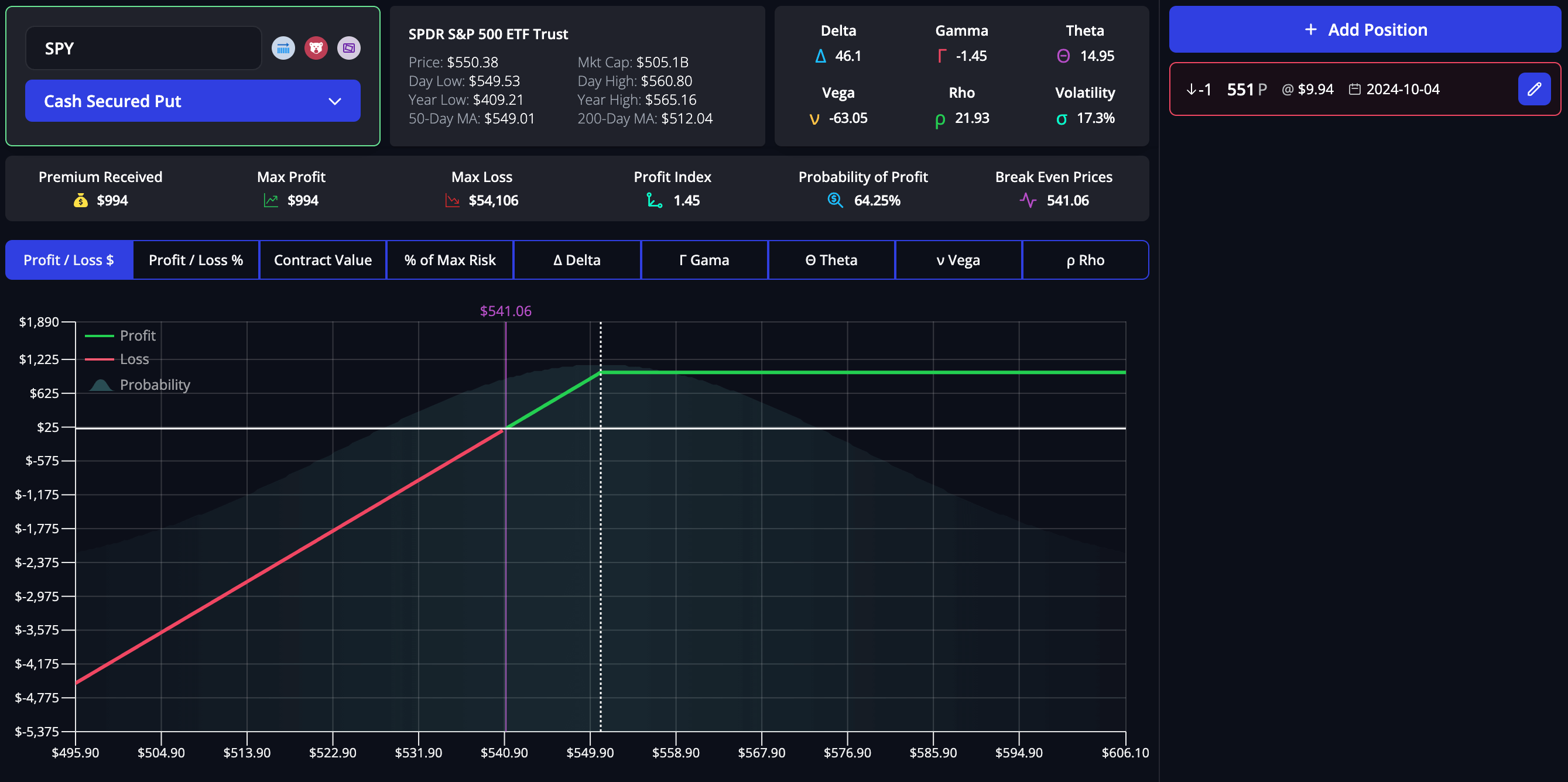
Cash-secured put selling is a conservative options strategy that involves selling a put option on a stock with the intention of potentially buying it at a lower price. The trader is required to set aside enough cash to cover the purchase of the stock if the put option is exercised, hence the term "cash-secured."
How Cash-Secured Put Selling Works
- Put Option Selling: The trader sells a put option, which obligates them to buy the underlying stock at a predetermined strike price if the buyer decides to exercise the option. This is typically done when the trader has a bullish outlook on the stock or wouldn’t mind owning it at a lower price.
- Cash Reserve: The trader must reserve enough cash to buy the stock if assigned, ensuring they can meet the obligation to purchase the shares at the strike price.
Cash-Secured Puts Profitability
- Premium Income: The primary profit source from a Cash-Secured Put is the premium received from selling the put option. If the stock price remains above the strike price, the put expires worthless, and the trader keeps the premium.
- Profitability in Neutral Markets: Even if the stock price falls, as long as it does not drop below the strike price minus the premium received, the strategy remains profitable. This strategy works best in neutral to slightly bullish markets, where there is little downside risk.
Cash-Secured Puts Market Conditions
To optimize cash-secured put selling, traders should consider current market conditions and adjust their strategy accordingly:
- Bullish Markets: In a strong bull market, the likelihood of the put option being exercised decreases, meaning the trader keeps the premium and does not end up purchasing the stock. In such scenarios, traders might select higher strike prices closer to the current market price to capture higher premiums. This increases the chance of the stock being assigned, but also provides a higher return if the stock price remains elevated or continues to rise. Alternatively, traders can choose shorter expiration dates to frequently reassess market conditions and maximize premium income.
- Neutral or Sideways Markets: In a neutral market, where the stock price is expected to stay relatively stable, selling puts can be highly effective. Traders should select strike prices slightly below the current stock price, which maximizes premium income while minimizing the risk of being assigned the stock. This approach allows the trader to potentially acquire the stock at a discount while profiting from the option premium.
- Bearish Markets: In bearish or declining markets, the risk of being assigned the stock increases, potentially resulting in purchasing shares at a loss. To adapt, traders should select strike prices significantly below the current market price, providing a larger margin of safety. The premium received can act as a buffer against losses. Additionally, traders could consider shorter-term options to reduce exposure to prolonged downward movements or combine this strategy with buying a protective put to create a synthetic covered call, limiting downside risk.
Cash-Secured Puts Example
Suppose a trader is interested in acquiring shares of a financial stock, currently trading at $30 per share. Expecting a slightly bullish market, the trader sells a put option with a $28 strike price for a $1.50 premium per share.
If the stock’s price remains above $28, the put expires worthless, and the trader keeps the $150 premium (100 shares x $1.50). If the stock’s price falls below $28, the trader buys the stock at an effective cost basis of $26.50 per share ($28 strike price minus $1.50 premium), which is a discount from the current price.
HIGH POTENTIAL TRADES SENT DIRECTLY TO YOUR INBOX
Add your email to receive our free daily newsletter. No spam, unsubscribe anytime.
3. Iron Condor
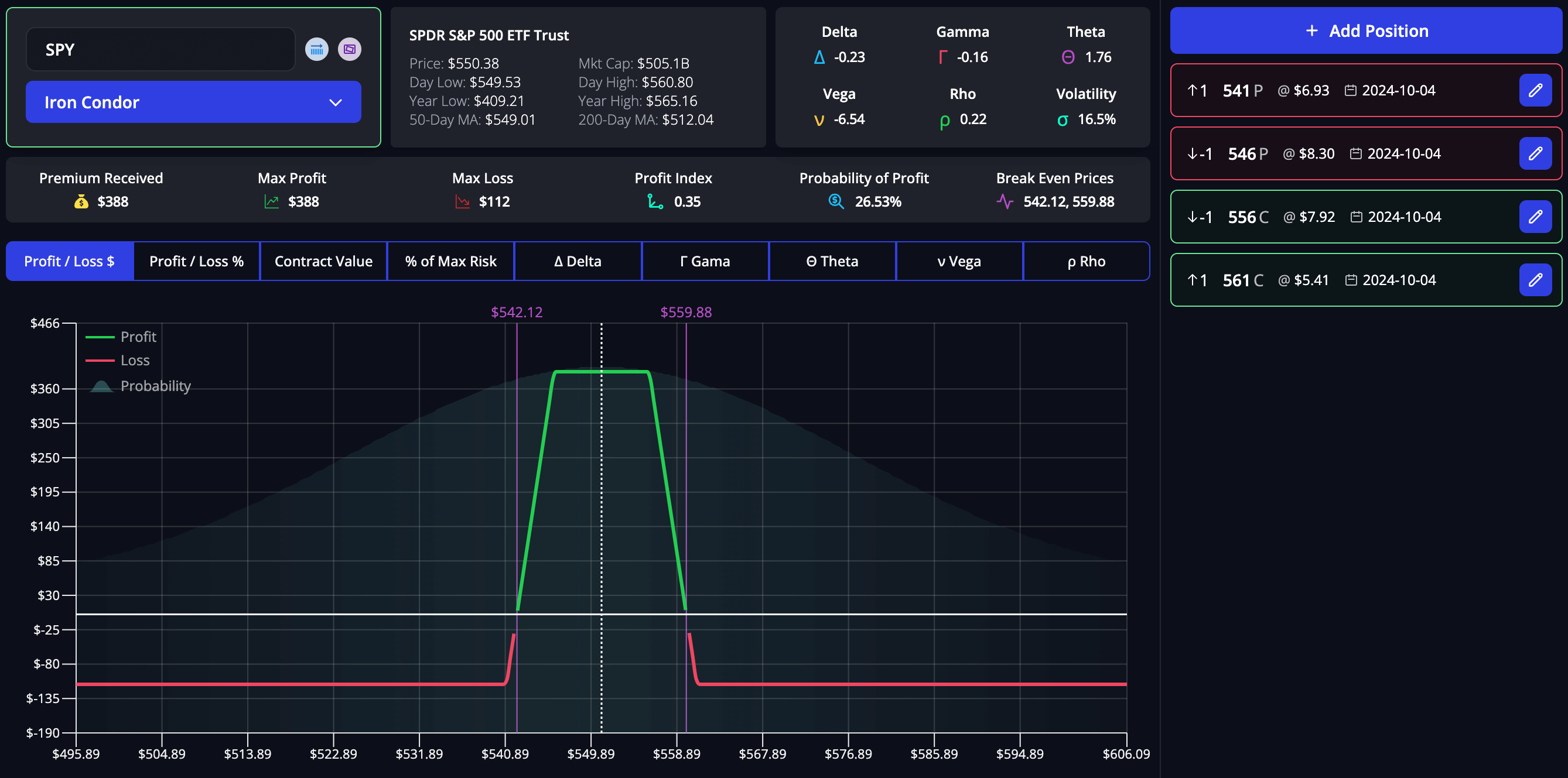
An iron condor is a neutral, non-directional options strategy that involves selling a lower-strike put and a higher-strike call, while simultaneously buying an even lower-strike put and a higher-strike call. This strategy aims to profit from low volatility in the underlying asset, where the price remains within a specific range through expiration.
How an Iron Condor Works
- Short Options: The trader sells an out-of-the-money put and an out-of-the-money call. These sold options are the core of the iron condor and represent the maximum profit potential from the premiums collected.
- Long Options: To protect against significant price movements, the trader buys a further out-of-the-money put and call. These long options serve as a hedge, limiting potential losses if the underlying asset's price moves significantly beyond the sold options' strike prices.
Iron Condor Profitability
- Range-Bound Profits: The Iron Condor strategy profits from the premiums collected from selling the put and call options if the underlying asset's price stays within the range of the two short strikes at expiration.
- Defined Risk and Reward: The maximum profit is the net premium received, while the maximum loss is limited to the difference between the strike prices of the long and short options minus the premium collected.
Iron Condor Market Conditions
To optimize the iron condor strategy, traders should adjust their approach based on the prevailing market conditions and volatility expectations:
- Low Volatility Markets: Iron condors are most effective in low-volatility environments, where the underlying asset is unlikely to experience significant price swings. In such markets, traders can select strike prices closer to the current market price to maximize premium income, as the risk of the asset reaching the long strikes is lower. This setup takes advantage of the stable price action, allowing traders to profit as the options decay in value.
- Moderate Volatility Markets: In environments with moderate volatility, traders need to be cautious as there is a higher risk of the underlying asset breaching the short strikes. To adapt, traders might widen the spread between the short and long options, providing a larger cushion against adverse price movements. This adjustment reduces the maximum potential profit but increases the probability of retaining some profit if the market moves moderately in either direction.
- High Volatility Markets: In high-volatility markets, the iron condor strategy becomes riskier due to the increased likelihood of the underlying asset moving significantly beyond the strike prices. In these conditions, traders should consider either avoiding iron condors altogether or placing them with very wide spreads, where the long options are far away from the current market price to minimize the chances of reaching them. Alternatively, traders could use iron condors on highly liquid and well-known indices or ETFs that tend to have less volatility than individual stocks.
Iron Condor Example
Suppose a trader sets up an iron condor on an energy stock, which is currently trading at $100 per share. The trader sells a $95 put and a $105 call, while buying a $90 put and a $110 call.
The net premium collected is $2 per share. If the stock’s price stays between $95 and $105 by expiration, all options expire worthless, and the trader keeps the $200 premium (100 shares x $2). If the stock moves outside this range, the trader’s maximum loss is capped at $300 ($5 difference between strike prices minus $2 premium collected, multiplied by 100 shares).
4. Vertical Spread (Bull Call or Bear Put Spread)

Vertical spreads involve buying and selling two options of the same type (either calls or puts) with different strike prices but the same expiration date. This strategy allows traders to take a directional view on the market with defined risk and reward parameters. The two main types of vertical spreads are the bull call spread, which is used in moderately bullish markets, and the bear put spread, which is utilized in moderately bearish markets.
How a Vertical Spread Works
- Bull Call Spread: The trader buys a call option with a lower strike price and sells a call option with a higher strike price, both with the same expiration date. This strategy profits when the underlying asset's price rises.
- Bear Put Spread: The trader buys a put option with a higher strike price and sells a put option with a lower strike price, both with the same expiration date. This strategy profits when the underlying asset's price falls.
Vertical Spread Profitability
- Balanced Profit and Loss: Vertical spreads provide a balanced approach to profit from price movements in the expected direction while limiting potential losses.
- Maximum Profit: The maximum profit is achieved if the underlying asset moves favorably to the point where both options are in-the-money (for bull call spreads) or out-of-the-money (for bear put spreads) at expiration.
- Limited Loss: The maximum loss is limited to the net premium paid for the spread.
Vertical Spread Market Conditions and Strategy Adaptation
Vertical spreads are versatile strategies that can be adapted based on market conditions to optimize performance:
- Moderately Bullish Markets (Bull Call Spread): In a moderately bullish market, traders can set up a bull call spread to profit from an expected gradual rise in the underlying asset's price. When adapting this strategy, consider selecting a spread with a strike price range that aligns with the anticipated price movement. If the market shows signs of strengthening bullish sentiment, traders might choose a slightly wider spread to capture more of the upward move while keeping costs manageable. Additionally, shorter expiration dates can be chosen to capitalize on the near-term upward momentum while minimizing time decay.
- Moderately Bearish Markets (Bear Put Spread): In a moderately bearish market, a bear put spread can be used to profit from an anticipated decline in the underlying asset’s price. Traders should choose a spread with strike prices that reflect their outlook for the asset's downward movement. If the market appears to be weakening further, widening the spread can provide greater profit potential if the asset continues to fall. Like the bull call spread, shorter expiration dates can be beneficial to minimize the impact of time decay, especially if the bearish trend is expected to be short-lived.
- Low Volatility Markets: In low-volatility environments, both bull call and bear put spreads can be effective, as they allow traders to take a directional stance with limited risk. In such markets, consider using spreads that are closer to the current market price (near-the-money) to increase the probability of achieving profitability. Narrower spreads might be more appropriate in low-volatility conditions to reduce the cost of the trade and capitalize on smaller price movements.
- High Volatility Markets: In high-volatility markets, the risks associated with vertical spreads increase, as large price swings can quickly move the underlying asset beyond the strike prices, potentially leading to losses. To adapt in these conditions, traders should consider wider spreads to provide more room for the asset's price to fluctuate without hitting both strike prices. Additionally, choosing longer expiration dates can allow more time for the market to move in the desired direction while reducing the impact of short-term volatility spikes.
Vertical Spread Example
A trader expects a healthcare stock, currently trading at $50 per share, to rise moderately over the next month. To capitalize on this outlook, the trader sets up a bull call spread by buying a $48 call and selling a $52 call, both expiring in one month.
The net premium paid for the spread is $1.50 per share. If the stock’s price rises to $52 or higher by expiration, the trader’s maximum profit is $2.50 per share ($4 difference between strike prices minus the $1.50 premium paid), or $250 for 100 shares. If the stock’s price remains below $48, the maximum loss is limited to the $150 premium paid.
5. Diagonal Spread
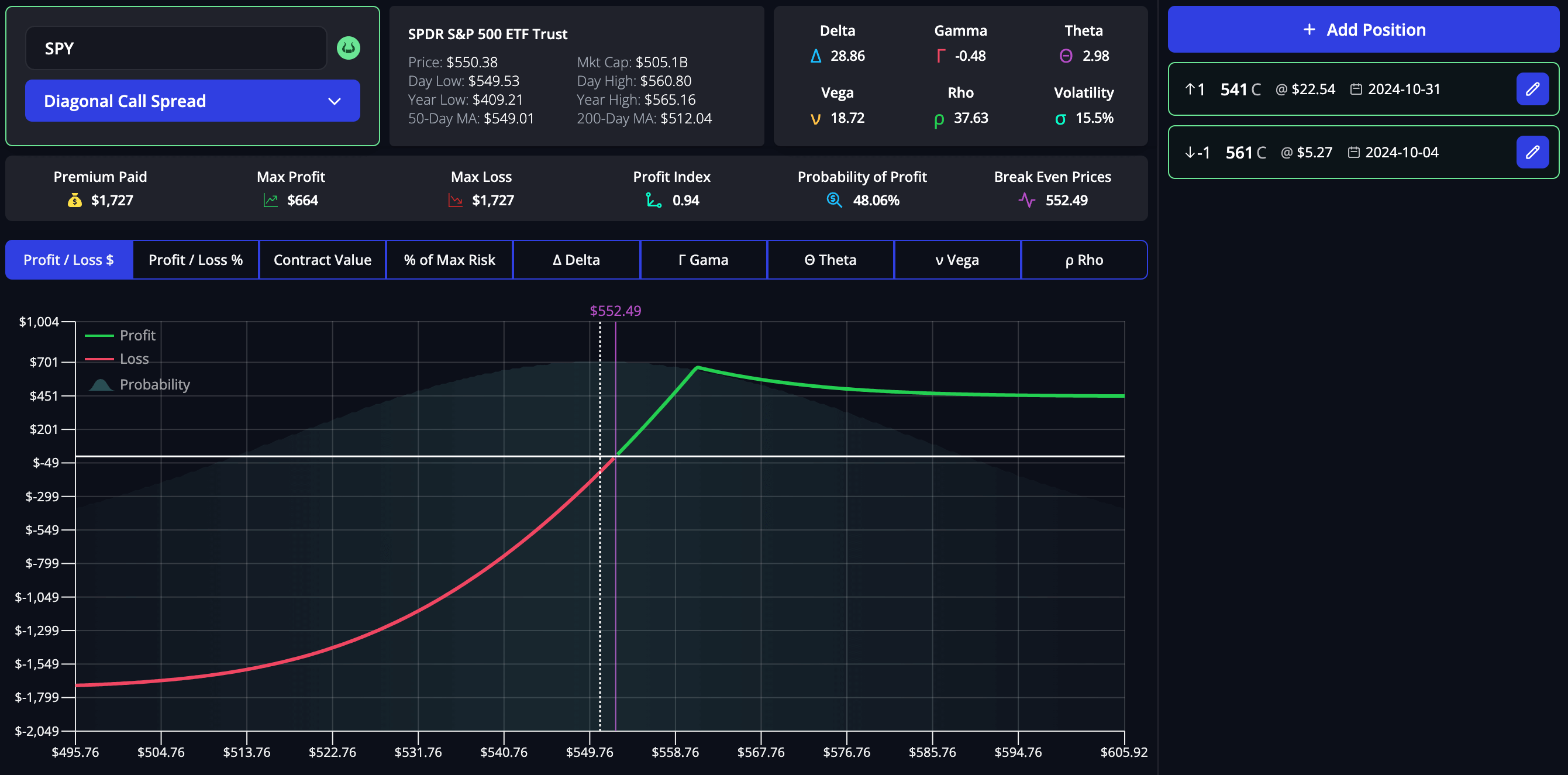
A diagonal spread is an advanced options strategy that combines elements of both vertical and calendar spreads. It involves buying a longer-term option and selling a shorter-term option at a different strike price. This strategy allows traders to capitalize on time decay (theta) and directional price movement of the underlying asset, making it a versatile choice for various market conditions.
How a Diagonal Spread Works
- Long Option: The trader buys a longer-term call or put option with a strike price that reflects the expected direction of the underlying asset.
- Short Option: The trader sells a shorter-term call or put option with a different strike price, typically closer to the current market price. This short option generates premium income and benefits from time decay.
Diagonal Spread Profitability
- Dual Benefits: Diagonal spreads profit from both the directional movement of the underlying asset and the time decay of the shorter-term option.
- Optimal Movement: The strategy is most profitable when the underlying asset moves towards the strike price of the short option by its expiration, allowing the trader to collect premium while maintaining potential gains from the longer-term option.
- Maximum Profit: Maximum profit is achieved when the shorter-term option expires worthless, and the longer-term option retains value.
Diagonal Spread Market Conditions
Diagonal spreads can be tailored to various market conditions, and traders should adjust their approach based on current market dynamics to optimize outcomes:
- Moderately Bullish Markets (Call Diagonal Spread): In a moderately bullish market, traders can use a call diagonal spread to benefit from a gradual increase in the underlying asset's price. The long call option is placed with a longer expiration and a strike price below the current market price, while the short call is sold with a nearer expiration and a strike price slightly above the current market price. This setup allows the trader to capture premium from the short call while maintaining potential gains from the long call if the asset appreciates over time. If the market conditions are particularly favorable, the trader can roll the short call to a higher strike price upon expiration to capture additional premium and further reduce the cost basis of the long call.
- Moderately Bearish Markets (Put Diagonal Spread): In a moderately bearish market, a put diagonal spread can be utilized to profit from a gradual decline in the underlying asset’s price. Here, the trader buys a longer-term put option with a strike price above the current market price and sells a shorter-term put option with a strike price below the current market price. This configuration allows the trader to benefit from the underlying asset’s decline while collecting premium from the short put option. If the market remains bearish, rolling the short put to a lower strike price at expiration can help lock in gains and continue generating premium income.
- Low Volatility Markets: In low-volatility environments, diagonal spreads can still be effective, but the focus should be on maximizing the premium collected from the short option due to slower price movements. Traders can choose strike prices that are closer together to enhance the potential premium income while ensuring that the spread's risk remains manageable. Additionally, selecting longer expiration dates for the long option can help reduce the impact of low volatility on potential gains.
- High Volatility Markets: In high-volatility markets, diagonal spreads can be more challenging due to the increased risk of significant price swings. To adapt, traders should consider widening the strike prices between the long and short options to provide more flexibility and reduce the likelihood of the underlying asset reaching the short option's strike price too quickly. Longer-term expiration dates for the long option can also provide a buffer against volatility, allowing more time for the strategy to play out favorably.
Diagonal Spread Example
A trader anticipates a gradual rise in an industrial stock, which is currently trading at $60 per share. To take advantage of this, the trader sets up a call diagonal spread by buying a long-term call option with a $55 strike price expiring in three months and selling a shorter-term call option with a $65 strike price expiring in one month.
The net debit for this spread is $3 per share. If the stock’s price moves towards $65 by the shorter-term option’s expiration, the trader profits from the premium collected on the short call while maintaining the potential for gains from the long call. If the stock remains near $65 after the short call expires, the trader may choose to sell another call option to continue generating income.
6. Straddles and Strangles
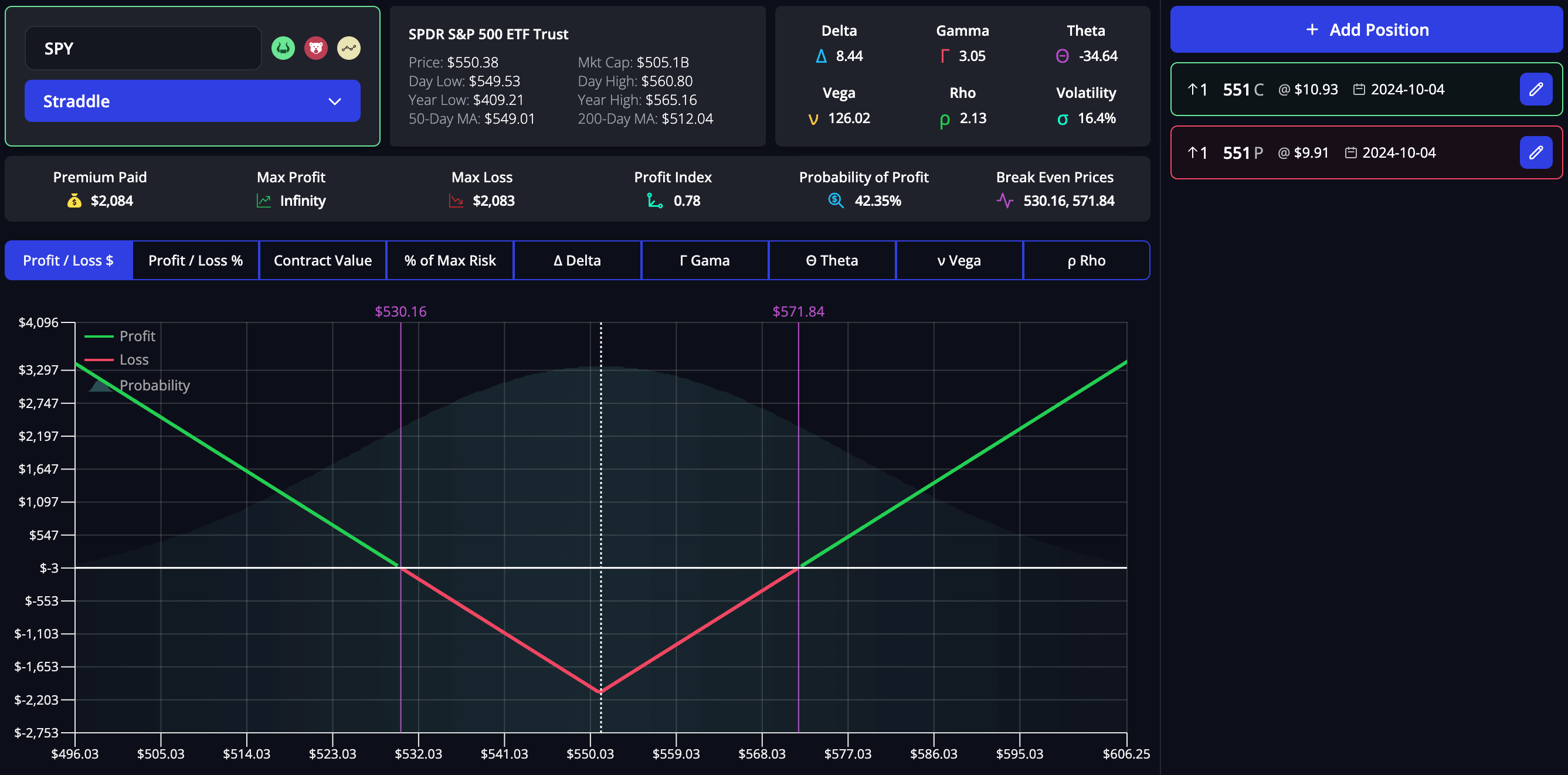
Straddles and strangles are options strategies designed to capitalize on significant price movements in the underlying asset, regardless of direction. Both strategies involve buying options that benefit from high volatility, making them ideal when traders expect substantial price swings but are uncertain about the direction.
How Straddles and Strangles Work
- Straddle: The trader buys a call option and a put option with the same strike price and expiration date. This setup allows the trader to profit if the underlying asset makes a significant move either up or down.
- Strangle: The trader buys a call option and a put option with different strike prices but the same expiration date. The call is usually slightly out-of-the-money, while the put is also slightly out-of-the-money. This strategy is less expensive than a straddle but requires a more substantial price movement to be profitable.
Straddles and Strangles Profitability
- Volatility Profits: Both Straddle and Strangle strategies profit from significant volatility in either direction.
- Unlimited Upside for Straddle: The maximum profit is theoretically unlimited for a straddle, depending on how far the asset moves from the strike price.
- Potential Gains for Strangle: For a strangle, profit is also potentially unlimited, but the asset must move further away from the two strike prices to achieve profitability.
- Limited Risk: The maximum loss for both strategies is limited to the total premium paid for the options.
Straddles and Strangles Market Conditions
Straddles and strangles are most effective in high-volatility environments, but they can be adapted based on different market conditions to optimize performance:
- High Volatility Markets: In highly volatile markets, where large price swings are expected, both straddles and strangles can be highly profitable. For a straddle, the strategy is most effective when the trader expects an aggressive move in either direction. In such cases, selecting at-the-money strike prices ensures that both the call and put have a high delta, allowing the trader to capture significant profits as the asset price moves away from the strike price. For a strangle, choosing slightly out-of-the-money strikes lowers the initial cost while still benefiting from large price swings, providing a wider range for potential profit if the asset moves substantially.
- Pre-Event Markets: Before major events such as earnings announcements, product launches, or economic data releases, implied volatility typically increases. Traders anticipating a significant move but unsure of its direction can use straddles or strangles to capture profits from the expected volatility spike. In this scenario, the key is to enter the trade before the event and potentially exit just after the event when implied volatility collapses and the actual price move materializes.
- Low Volatility Markets: In low-volatility environments, these strategies are less favorable due to the reduced likelihood of significant price movements. However, if a trader anticipates an upcoming shift in market conditions that could lead to increased volatility (such as geopolitical tensions or unexpected economic reports), they might enter a straddle or strangle in anticipation of that change. To reduce the cost in such conditions, traders can opt for strangles instead of straddles, as the out-of-the-money options are cheaper and still provide potential profit if a substantial move occurs.
- Neutral or Range-Bound Markets: Straddles and strangles can also be set up in neutral or range-bound markets if the trader expects a breakout in either direction. In this case, patience is required as the strategy will initially lose value if the market does not move. However, if the trader is correct about an impending breakout, the strategy can quickly become profitable once the asset moves beyond the strike prices of the options.
Straddle Example
A trader expects a significant price move in a media stock around its upcoming earnings announcement but is unsure of the direction. The stock is currently trading at $100 per share. To capitalize on this, the trader sets up a straddle by buying a $100 strike call and a $100 strike put, both expiring in one month.
The total premium paid is $5 per share ($3 for the call and $2 for the put). If the stock’s price moves significantly in either direction by more than $5, the trader begins to profit. For instance, if the stock moves up to $110 or down to $90, the trader could see substantial gains due to the intrinsic value of either the call or the put option.
7. Butterfly Spread
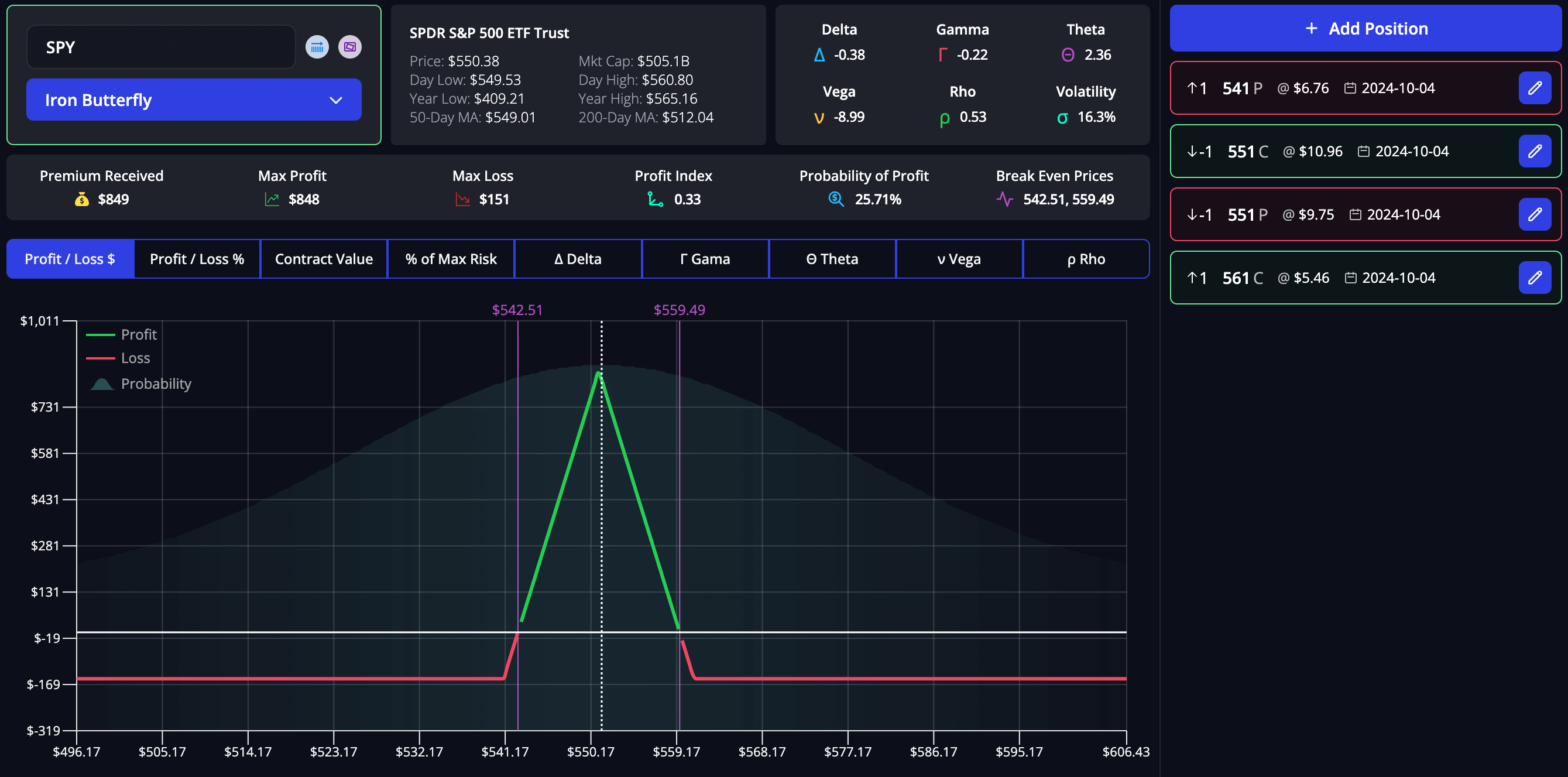
A butterfly spread is an advanced options strategy designed to profit from low volatility and minimal price movement in the underlying asset. It involves using three different strike prices to create a position that offers a balanced approach with limited risk and reward. The strategy can be constructed using either call options (bullish outlook) or put options (bearish outlook) and aims to achieve maximum profit if the underlying asset's price is at the middle strike price at expiration.
How a Butterfly Spread Works
- Long Options: The trader buys a lower strike call and a higher strike call (for a bullish butterfly spread) or a lower strike put and a higher strike put (for a bearish butterfly spread). These long options define the outer wings of the butterfly and limit potential losses.
- Short Options: The trader sells two calls (or puts) at a strike price between the two long options. This middle strike price is where the maximum profit is achieved if the underlying asset's price converges at expiration.
Butterfly Spread Profitability
- Limited Risk-Reward: Butterfly spreads have a limited risk-reward profile.
- Maximum Profit Scenario: The maximum profit is realized if the underlying asset's price is at the middle strike price at expiration, where both short options expire worthless and the long options are either in-the-money or worthless.
- Defined Risk: The maximum loss is limited to the net premium paid for the spread, making it a low-cost strategy with a defined risk.
Butterfly Spread Market Conditions
To optimize the butterfly spread strategy, traders should tailor their approach to align with current market conditions:
- Low Volatility Markets: Butterfly spreads are most effective in low-volatility environments where the underlying asset is expected to remain near a particular price level. In these conditions, traders can use at-the-money strike prices to maximize the potential for profit. The narrow range of expected movement reduces the likelihood of the underlying asset moving beyond the outer strikes, making this setup particularly advantageous. Traders should consider expiration dates that match the period of expected low volatility, typically opting for shorter timeframes to minimize time decay's adverse effects on the position.
- Moderately Volatile Markets: In moderately volatile markets, there is an increased risk that the underlying asset may move beyond the strike prices of the butterfly spread. To adapt, traders can widen the spread between the outer strikes, creating a "wider" butterfly that offers a broader range of profitability. While this approach reduces the maximum potential profit, it increases the probability of achieving some level of profit if the asset moves moderately. Additionally, traders can choose longer expiration dates to allow more time for the underlying asset to settle near the middle strike price.
- High Volatility Markets: In high-volatility markets, butterfly spreads are less favorable due to the increased risk of the underlying asset moving significantly beyond the strike prices. However, if a trader expects volatility to decrease sharply after an event (such as an earnings announcement), a butterfly spread might be constructed just before the event to capture potential profits from the anticipated reduction in volatility. In such cases, choosing wider spreads and longer expiration dates can provide a buffer against unexpected large moves and allow more flexibility in managing the position.
- Directional Markets: Butterfly spreads can also be adapted for directional trades, known as "broken-wing" or "unbalanced" butterflies. This variation involves adjusting the strikes to create an asymmetric payoff, where the trader expects the underlying asset to move towards one of the outer strikes rather than the middle strike. This adaptation allows traders to capitalize on a specific directional outlook while still benefiting from the limited risk profile of a butterfly spread.
Butterfly Spread Example
A trader believes that a biotech stock, currently trading at $75 per share, will remain close to this price over the next month due to an upcoming period of low volatility. To capitalize on this expectation, the trader sets up a butterfly spread by buying a $70 call, selling two $75 calls, and buying a $80 call, all expiring in one month.
The net cost of the spread is $1 per share. If the stock’s price is at $75 at expiration, the trader’s maximum profit is $4 per share ($5 difference between the strike prices minus the $1 premium paid), or $400 for 100 shares. If the stock’s price moves significantly above $80 or below $70, the maximum loss is limited to the $100 premium paid.
Which Options Strategy Is Right for You?
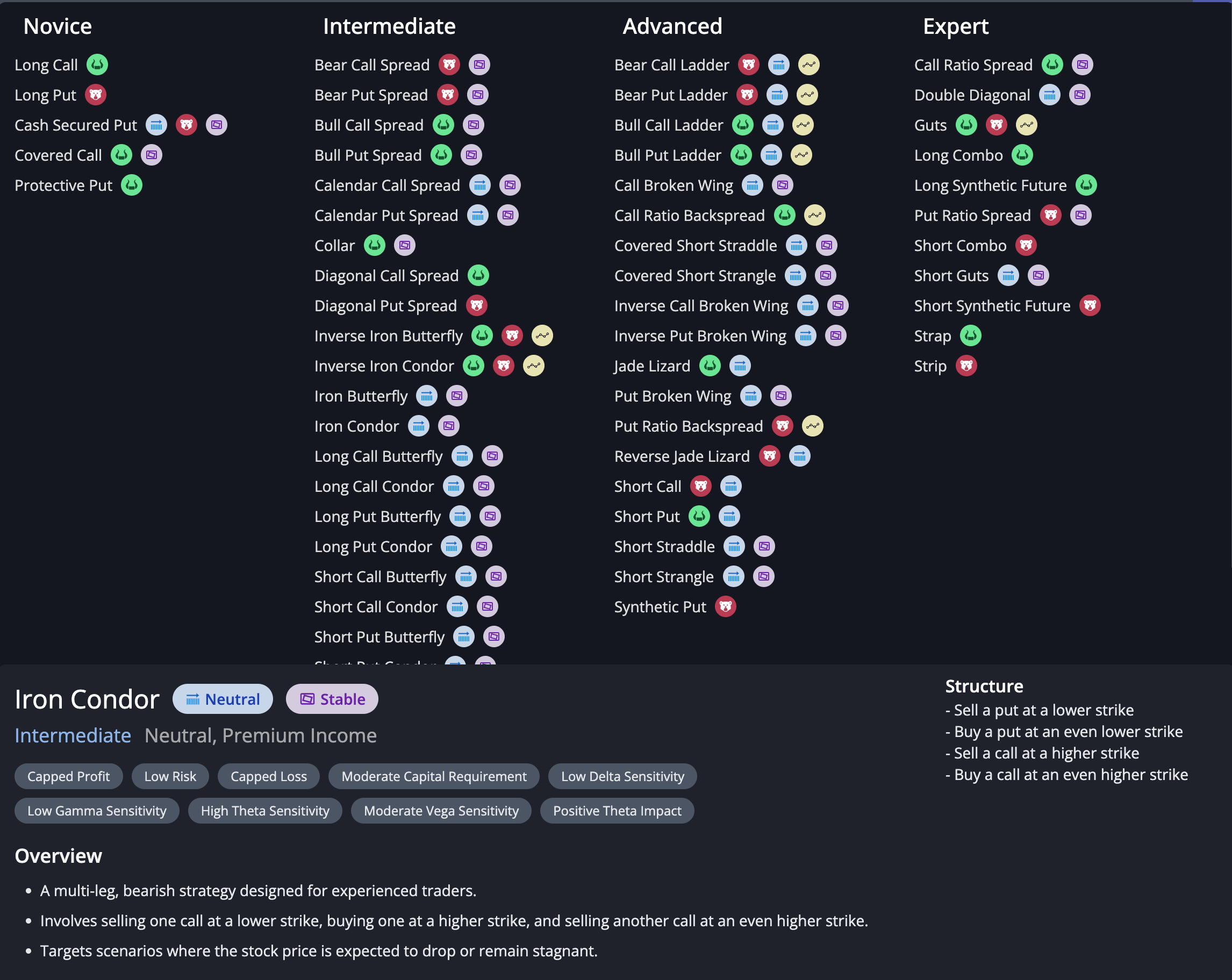
Choosing the right options trading strategy isn’t just about understanding the mechanics of each approach; it’s about aligning the strategy with your unique trading goals, risk tolerance, and market outlook. Here’s a breakdown of different trading personas and the strategies that best suit their needs:
The Income Seeker: Covered Call Writing and Cash-Secured Put Selling
If you’re a trader looking for consistent income with a relatively lower risk profile, covered call writing and cash-secured put selling are strategies you should explore further.
- Covered Call Writing: This strategy is ideal for those who already own shares and want to generate additional income through premiums. It’s perfect for a moderately bullish or neutral market where you expect the stock price to remain stable or rise slightly. The premium collected provides a buffer against minor price declines, offering a conservative approach to enhance your portfolio's returns.
- Cash-Secured Put Selling: For traders comfortable with potentially owning a stock at a lower price, cash-secured put selling offers a great way to earn premiums while waiting for the right buying opportunity. This strategy is suitable for neutral to slightly bullish markets and is an excellent choice if you’re looking to buy stocks at a discount while getting paid for your patience.
The Volatility Trader: Straddles and Strangles
Are you someone who thrives on market movement and volatility? Do you anticipate big swings in stock prices, but are unsure of the direction? Then, straddles and strangles might be your best bet.
- Straddles: This strategy allows you to profit from significant price movements in either direction. It’s ideal for traders who expect high volatility around events like earnings reports, major economic announcements, or political events. If you’re confident that “something big” is about to happen, but not sure whether it will be good or bad news, straddles let you capitalize on the movement itself.
- Strangles: Similar to straddles but slightly more conservative, strangles are a great option if you want to keep initial costs lower. This strategy requires a more significant move to be profitable but can be a smart choice when you expect volatility but want to minimize upfront costs.
The Market Neutralist: Iron Condor and Butterfly Spread
If your outlook is market-neutral and you believe that a stock will remain within a specific range, or if you’re looking for a strategy that benefits from low volatility, then iron condors and butterfly spreads are for you.
- Iron Condor: Perfect for traders who expect a stock to stay within a defined range. The iron condor allows you to profit from low volatility while limiting potential losses. This strategy is ideal for a market that is not expected to move significantly in either direction and can provide steady income with controlled risk.
- Butterfly Spread: For those who want to benefit from low volatility and expect the stock price to settle near a specific point, butterfly spreads are an excellent choice. This strategy is particularly effective when the trader expects the underlying asset to gravitate towards a particular price level by expiration, allowing for profit with limited risk exposure.
The Directional Trader: Vertical Spreads and Diagonal Spreads
If you have a specific directional bias—whether bullish or bearish—and want to capitalize on moderate price movements, vertical spreads and diagonal spreads could be the perfect fit.
- Vertical Spreads: Whether you’re moderately bullish or bearish, vertical spreads (bull call or bear put spreads) allow you to take a directional view with defined risk and reward. This strategy is excellent for traders who expect the underlying asset to move in a particular direction but want to limit potential losses in case the market doesn’t go as planned.
- Diagonal Spreads: Combining aspects of both time and price, diagonal spreads are great for traders who expect gradual price movements over time. This strategy allows you to profit from both time decay and directional movement, making it a versatile choice for those with a longer-term outlook on a stock’s performance.
Master the Market with Confidence
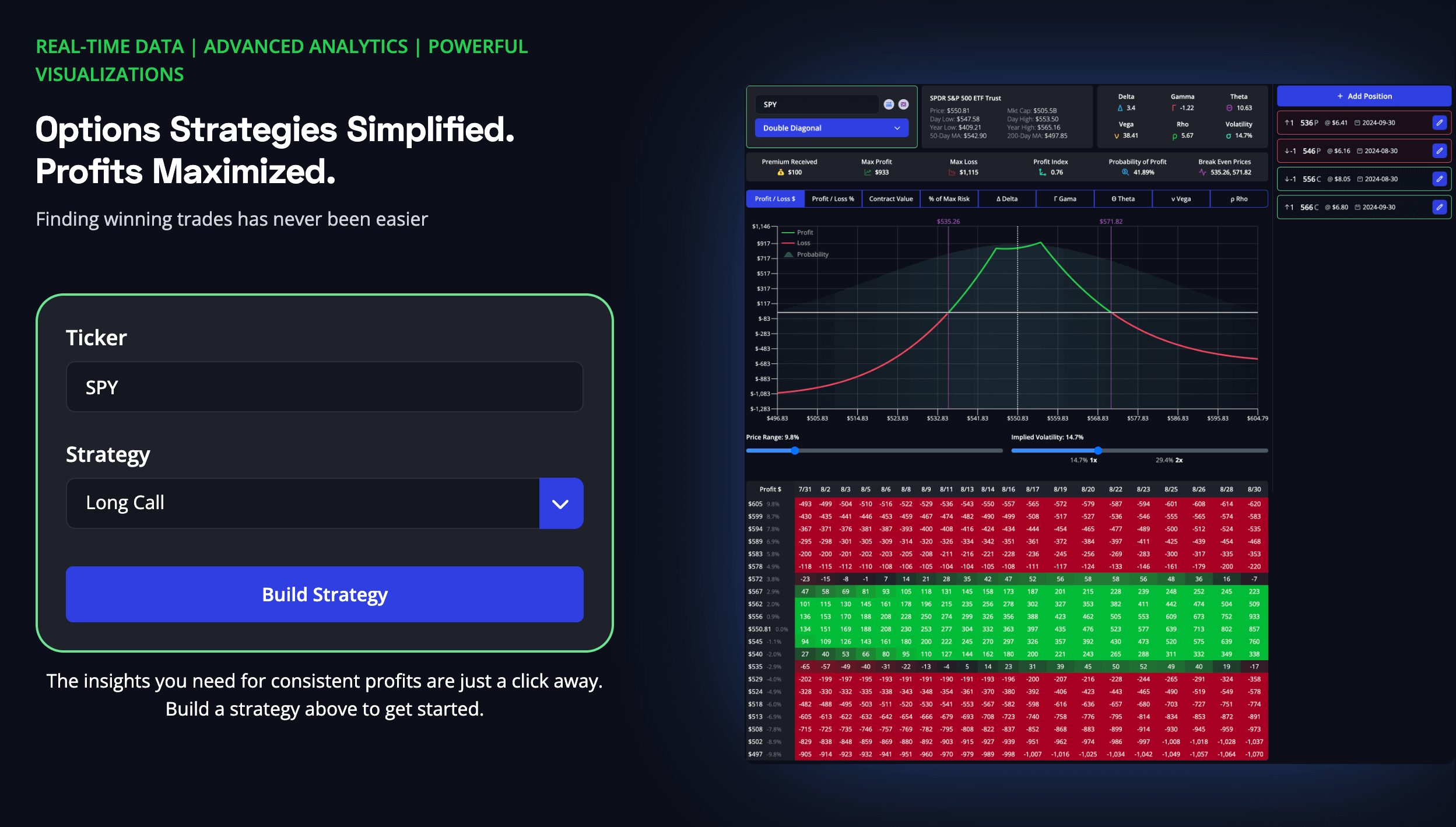
As you’ve seen, mastering options trading is all about choosing the right strategy for the right market conditions. The strategies covered in this guide are powerful tools to help you achieve your financial goals, but they’re just the beginning.
To truly elevate your trading game, you need more than just strategies—you need the right tools. The InsiderFinance Options Profit Calculator is designed to be that game-changing tool, giving you an edge in every trade you make. Imagine being able to visualize potential profits, calculate risk, and optimize your strategies with just a few clicks. Here’s how the InsiderFinance Options Profit Calculator can help you turn your knowledge into action:
- Accurate Profit Projections: Instantly calculate potential profits and losses for any strategy, helping you make informed decisions and maximize your returns.
- Strategy Optimization: Compare different strategies side-by-side and see which one aligns best with your market outlook, ensuring you choose the most effective approach every time.
- Risk Management Made Easy: Easily assess the risk-reward ratio of your trades to protect your capital and manage your exposure, a critical aspect highlighted throughout this article.
- Real-Time Market Data: Access up-to-date market data and volatility metrics directly within the calculator, allowing you to adapt your strategies based on current conditions seamlessly.
- User-Friendly Interface: No complicated formulas or guesswork—just straightforward calculations that let you focus on executing your strategies with confidence.
Ready to take your options trading to the next level? Try the free InsiderFinance Options Profit Calculator today and see how it can transform your trading approach. Empower yourself with the tools and insights needed to trade smarter, not harder.
Start for free now and make every trade count!
HIGH POTENTIAL TRADES SENT DIRECTLY TO YOUR INBOX
Add your email to receive our free daily newsletter. No spam, unsubscribe anytime.
FAQs
What are the best options trading strategies for beginners?
Beginners should consider covered call writing and cash-secured put selling due to their lower risk and straightforward mechanics.
How can I profit from options trading in a low-volatility market?
In a low-volatility market, strategies like iron condors and butterfly spreads can be effective for generating income with controlled risk.
What is the difference between a straddle and a strangle in options trading?
A straddle involves buying a call and put with the same strike price, while a strangle uses different strike prices, both benefiting from volatility.
When should I use a bull call spread in options trading?
A bull call spread is ideal in a moderately bullish market where a trader expects a gradual rise in the underlying asset’s price.
How does a diagonal spread work in options trading?
A diagonal spread involves buying a longer-term option and selling a shorter-term option at a different strike price, benefiting from both time decay and directional movement.
What is the best strategy for trading options in a high-volatility market?
In high-volatility markets, strategies like straddles and strangles can capitalize on significant price movements in either direction.
How do I choose the right options trading strategy for my risk tolerance?
Align your strategy with your risk tolerance by considering the market conditions, your financial goals, and the level of risk you’re willing to take.
What is a butterfly spread in options trading, and when should I use it?
A butterfly spread profits from low volatility and is best used when a trader expects the underlying asset to remain stable near a specific price.
How can I manage risk effectively in options trading?
Effective risk management in options trading involves choosing strategies with defined risk, setting stop-loss levels, and adjusting positions based on market conditions.
What tools can help me optimize my options trading strategies?
Tools like the InsiderFinance Options Profit Calculator can help optimize strategies by providing accurate profit projections, real-time data, and risk assessments.








